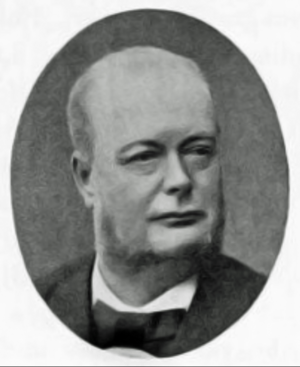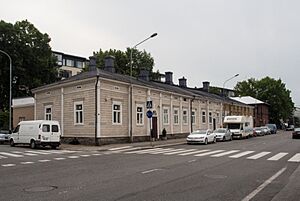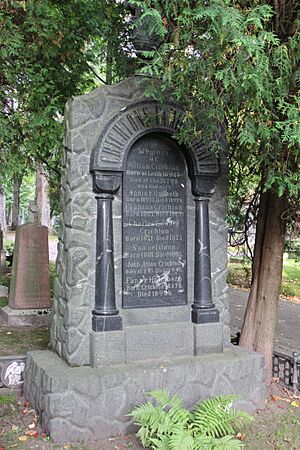William Crichton (engineer) facts for kids
Quick facts for kids
William Crichton
|
|
|---|---|
 |
|
| Born | 29 November 1827 Leith, Scotland
|
| Died | 10 April 1889 (aged 61) |
| Nationality | Scottish |
| Citizenship | British |
| Occupation | engineer |
| Employer |
|
| Successor | John Eager |
| Spouse(s) | Annie Elizabeth née Owen |
| Children | Louisa Gifford Elisabeth (b. 1856) George (b. 1858) William (b. 1860) Alexander Owen (b. 1862) Anne Mary (b. 1864) John Allan (b. 1865) Alfred (b. 1868) Rurik (b. 1870) Lilly Vera (b. 1872) James Dunlop (b. 1874) Margaret Jemima (b. 1876) Fanny Julin (b. 1879) |
| Awards |
|
William Crichton (born November 29, 1827 – died April 10, 1889) was a talented Scottish engineer and shipbuilder. He spent most of his working life in Turku, a city in what was then the Grand Duchy of Finland.
When he was 23, Crichton moved to Turku. He took charge of building a steam engine at a local engineering company called Cowie and Eriksson. After two years, he moved to Helsinki to work for Fiskars. However, the Crimean War began, and he was arrested because he was British. He was sent to Saint Petersburg. Luckily, his family connections helped him get released. He then worked for Izhorsk Works for eight years.
In 1862, Crichton returned to Turku. He was offered a chance to buy half of Cowie & Eriksson Company. The company was renamed W:m Crichton & C:o. Under Crichton's leadership, it grew into the biggest company in Turku. They mainly built ships and steam engines. Their main customer was the Imperial Russian Navy.
Crichton managed the company until he passed away in 1889. He had twelve children. They later sold the company to other investors. Crichton's name was still used in the shipbuilding industry until 1965.
Contents
William Crichton's Early Life
William Crichton was born in Leith, Scotland. His father, George Crichton, owned ships. His company was one of the first to use steamships in Scotland. These ships traveled between Leith and London. William's mother was also from Leith. Her father was a log dealer, whaler, and shipowner.
William had four brothers and one sister. His older brothers, Alexander and Edward, studied at the Royal Naval College, Greenwich. They then worked for engineering companies in Scotland. Their example inspired William. He studied in Leith until he was ten. Then he went to Hill Street Institution in Edinburgh, where he finished school at 14.
His father died in 1841. William followed his brother Alexander to Greenock. There, he worked as an intern at Scotts Shipbuilding and Engineering Company. After two years, he moved to Shotts Iron Company, where his brother Edward worked. When that company closed, William moved to Glasgow. He worked for Robert Napier and Sons as a draftsman.
In 1848, he went to sea. He worked as an engineer on the SS Royal Victoria. This ship sailed between London and Granton. During the winter, he studied. The next year, he worked on the SS Isabella Napier. While his brothers often changed jobs, William focused on designing and drafting.
First Adventures in Turku
In the summer of 1850, Crichton got a letter. A Finnish engineering company, Cowie and Eriksson, offered him a job. They wanted him to be a supervisor for three years. We don't know how they found him.
Crichton, who was 23, was excited. He had wanted to move to Russia for a long time. His great-uncle, Sir Alexander Crichton, and his cousin, Sir William Crichton, had already built careers there. Russia was building its merchant shipping fleet. Many British experts had moved there since the 1700s. Thousands of British people lived in Saint Petersburg. Many held important jobs and were part of the upper class. Even though the offer was from Turku, a smaller city, Crichton probably saw it as a way to start his career in Russia.
Crichton was hired to lead a project. He had to build a steam engine for the steam frigate Rurik. This was the biggest ship ever built in Finland at that time. The shipyard, Gamla Warfsbolaget i Åbo, was Cowie & Eriksson's most important customer. The companies were close to each other, on opposite sides of the Aura River.
Crichton found the work difficult. The tools were not very good. Also, the company owners, David Cowie and Anders Thalus Eriksson, did not get along. When Crichton became very ill, Cowie's wife took care of him. He met her brother, Samuel Owen Jr. Samuel's father, Samuel Owen, was a famous engineer who helped bring the Industrial Revolution to Sweden. Owen Jr. had moved to Turku a few years earlier. He was working on the same project as Crichton and was staying at his sister's home.
After getting better in 1851, Crichton went on holiday to Sweden. He met Mr. Fletcher, a relative of Mrs. Owen. Fletcher introduced him to Motala Verkstad, a major Swedish steam engine maker. Crichton also met Owen's oldest daughter, Annie Elizabeth, and fell in love with her. When Owen's wife and four children moved to Turku in 1852, William and Annie met again. They got engaged the next year. They planned to marry after the shipbuilding project was finished.
A New Job, Arrest, and Moving to Saint Petersburg
Crichton signed a new agreement with Fiskars. This company planned to open a factory in Helsinki. In the autumn of 1853, Crichton traveled to England to buy the machines needed. He returned in January 1854 to set them up in Hakaniemi.
But world events changed everything. The United Kingdom and France started the Crimean War against Russia on March 28. Because of the war, it was impossible to bring in the machines. As a British citizen, Crichton decided to go back to the UK to wait for the war to end.
That same evening, when he went to pick up his passport, military and Finnish police were waiting for him. They told him to gather his drawings and notes. They ordered him to leave for Saint Petersburg with his papers in a sealed envelope. An officer and a policeman went with him.
When Crichton arrived in Saint Petersburg, he was treated well. But he was not allowed to leave the arrest room. After a few days, he asked to speak to the department leader. Crichton asked if they had found anything secret in his papers. The answer was no, but they said he would be sent to Moscow. Crichton then mentioned his great-uncle, Sir William Crichton. His great-uncle had been a doctor for Grand Duke Nicholas, who later became Tsar Nicholas II. The department leader said this might change things and that they would investigate.
As a result, Crichton was released. He was sent just twenty miles away to Sir William Crichton, who welcomed him warmly. William Crichton stayed with his great-uncle for two months. During this time, he met General Alexander Wilson. Wilson managed the state-owned Alexandrosk factory and Izhorsk Works in Kolpino. Wilson hired Crichton as the chief engineer in Kolpino. Soon after, he also found a place for Samuel Owen. Owen had to leave the Rurik project because of the war. He moved to Kolpino with his family.
Crichton had finally achieved his dream: a good job at a state-owned engineering company.
Life in Kolpino
William Crichton and Annie Elizabeth Owen got married in an English church in Saint Petersburg in November 1854. Their family grew in the following years:
- Daughter Louisa was born in 1856.
- Son George was born in 1858.
- Son William Jr. was born in 1860.
- Son Alexander Owen was born in 1862.
Crichton did not write much about his work at Izhorsk Works. However, we can guess some things from company records and his skills. After losing the Crimean War, the Russian Navy ordered new armored ships. These ships needed powerful steam engines with propellers and high-pressure boilers. They had to be very fast, at least 15 knots. This meant using the newest technology.
It's interesting that their second child, George, was born in Edinburgh, Scotland. This suggests Crichton had spent some time there and brought his family with him. Another important fact is that Crichton received a significant award, the Great Golden Medal with Stanislaus ribbons, around 1860.
It seems Crichton traveled to the UK to learn about the latest steam technology. As a British citizen, he could do this easily using his contacts. It's likely that this new technology was used successfully in the powerful engines built in Izhorsk, which is why Crichton received the award.
Back to Turku
In 1862, Crichton received a letter from a businessman in Turku named Erik Julin. Julin told Crichton that he had bought Anders Thalus Eriksson's shares in Cowie & Eriksson. He also said that David Cowie was ready to sell his shares. Julin was looking for a skilled business partner to run the company with him. He suggested that Crichton buy Cowie's shares. After many talks, Crichton bought the other half of the company from Cowie for 32,810 silver roubles.
W:m Crichton & C:o Company
The company was renamed W:m Crichton & C:o, and Crichton became its managing director. His family moved into a wooden house at Itäinen Rantakatu 56. This house was right next to the factory and the Aura River.
Crichton, now 35, was the owner and manager of a company where he could use all his skills. He expanded the company to include building steamships. In 1864, he built a new ship cradle by the river. A few years later, he built an even bigger one. He replaced old machines with modern equipment, likely bought from the UK. The foundry (where metal is cast) was made bigger, and new workshops were built. Since the company still built wooden ships, Crichton invested in a steam-powered sawmill. It was located next to the river, downstream from the other buildings. Meanwhile, the Turku Old Shipyard, on the other side of the river, built the largest shipbuilding cradle in Finland.
The 1850s, 1860s, and 1870s were a time of fast growth and economic changes. New laws were made for companies and banks in 1864. At the same time, Finland got its own money, the Finnish mark. Taxes on goods were lowered, and a railway network began to grow. The Estates (a kind of parliament) met in 1863, followed by changes in how local towns were run. Despite challenges like the famine of 1866–68, people felt hopeful. Finns wanted to develop their country.
W:m Crichton & C:o always had plenty of orders, and the company kept growing. Crichton had good connections in Saint Petersburg. About 20% of the company's orders came from Finland. The rest came from the Russian military and other customers. Crichton kept his British citizenship. Soon after settling in Turku, he was made Her Majesty's Vice Consul in Turku and Åland. During his years in Kolpino, he had learned to speak Russian. In Turku, he used Swedish, which was widely spoken then.
Because ships were becoming larger and more valuable, Crichton and Julin decided to protect their personal money. In 1874, they changed the company's legal status to a limited company. Julin died that same year. His son, John Julin, then took over the ownership through his trading house.
In the years that followed, the Russian military became W:m Crichton & C:o's most important customer. A big project was an order for six torpedo boats, which were delivered in 1878.
It was unusual for a small company like W:m Crichton & C:o to compete with the large shipyards in Saint Petersburg for navy orders. Getting military orders was complicated. A successful business needed to be trusted and have the right connections. Crichton's connections from Kolpino likely helped him. He also probably gathered information about the latest technology during his trips to the UK and shared it with the Russian Navy. In 1877, he received the Order of Saint Stanislaus.
In 1883, he took over the nearby Turku Old Shipyard. It's not clear how he paid for this. This timing fits with Russia's decision to build a fleet of torpedo boats. Perhaps Crichton traveled to the UK in the mid-1870s to learn about torpedo boat technology. Another interesting detail is that when the Russian Navy ordered 100 torpedo boats, mostly from navy yards, six of them were ordered from Crichton. His company was the only privately owned shipbuilder involved in this order.
In the late 1870s, Crichton met a Welsh engineer named John Eager in Saint Petersburg. He hired Eager for his own company. Eager was an expert in fast ships, like torpedo boats. In the following years, W:m Crichton & C:o built many relatively small, fast ships. These were built in two large wooden sheds the company put up on the old shipyard land. They also built larger ships, such as two oil tankers for the Caspian Sea and the gun boat Bobr. The Bobr was ordered for the Russian Pacific Fleet.
After taking over the Old Shipyard, W:m Crichton & C:o became the biggest company in Turku. It had 936 employees and a turnover of 1,589,000 marks. When William Crichton died in April 1889, the company had many orders. John Eager was made the new company manager. None of Crichton's twelve children wanted to continue the business. His shares were sold to investors.
Crichton's name was used in the Turku shipbuilding industry until 1965. This included the name of his company, as well as the Ab Crichton and Crichton-Vulcan companies.




